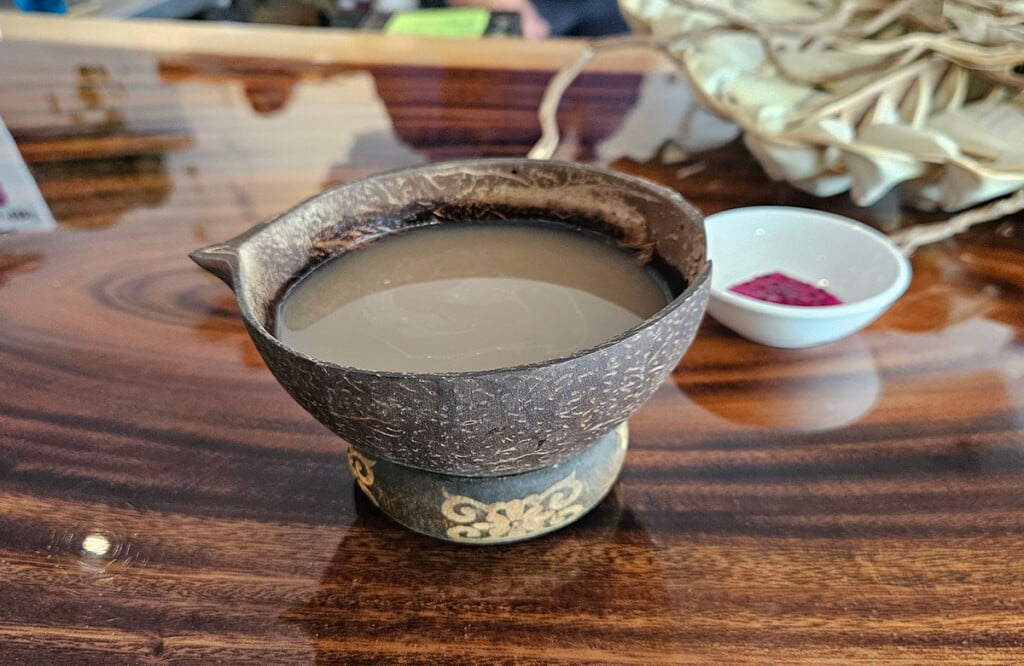Dinner Solved
THE STORY. Can you cook a gourmet dinner and enjoy the party, too? Three top chefs use their classic culinary skills to lead us through a successful dinner, start to finish. Because, once you solve the mystery of how to throw a great dinner party—the who, where and with what delicious dishes—everyone wins.

Photos by Alex Viarnes |
FROG LEGS KaraageACTIVE TIME: 15 MIN, START TO FINISH: 24 HOURS
SERVES 10“Tastes like chicken!” says Matsubara. Go for the unexpected at your next dinner party and switch out basic chicken for frogs legs. Overall, “the meat is flavorful and takes well to a marinade,” and, because it’s on the bone, these fun conversation starters are also extra succulent. |
| 4 pounds frog legs (found in Chinatown) potato starch for dusting FOR MARINADE 1. TO MARINATE: 2. TO FRY: 3. TO ASSEMBLE: |
 |
| Clue:
“Kewpie mayonnaise is very different from traditional mayonnaise,” says Chef Matsubara. “It’s more acidic and lends itself better to the true karaage experience.” |
 |
Next: Chef Matsubara’s Japanese Yellow Tail a la Plancha

Photo by Alex Viarnes |
JAPANESE YELLOW TAIL A LA PLANCHA with roasted garlic & carmelized leek sauce
ACTIVE TIME: 15 MIN, START TO FINISH: 45 MIN
SERVES 10
In Spanish, a la plancha refers to cooking on a flat surface. Locally, you may see it referred to as tataki-style. Whatever you choose to call it, cooking the fish at home in a cast-iron skillet on high heat is ideal for searing fish; it creates an excellent crust, while keeping the center rare. Sliced into pieces, this chopstick-worthy dish is perfect for appetizer grazing.
| 1 pound hamachi or ‘ahi
FOR SAUCE FOR GARNISH |
1. TO COOK LEEKS: Cook leeks in a pan with two tablespoons of oil until dark golden brown. 2. TO ROAST GARLIC: 3. TO MAKE SAUCE: 4. TO SEAR FISH: 5. TO ASSEMBLE: |
| Clue:
“If you can, pick up the specific ingredients Matsubara recommended. “It affects the final flavor,” he says.”
|
 |
Next: Chef Alan Takasaki and Onaga with compressed zucchini
TO COME: Chef Mann Vann’s BLACK SESAME Panne Cotta

Photo by Robbyn peck |
ONAGA with COMPRESSED Zucchini
ACTIVE TIME: 15 MIN, START TO FINISH: 4 HRS SERVES 4
This fresh dish looks great and tastes even better-plus, it’s healthy. Compressing the zucchini takes time, but it can be prepared the day before and left in the fridge overnight. Steaming the fish is also simple. “Just do it slowly,” suggests Takasaki.
4 zucchini (green skin peeled off and diced, flesh chopped coarsely)
4 squash (chopped)
1/2 cup extra virgin oil
1/4 teaspoon kosher salt
5 branches thyme
12 leaves basil (diced)
4 onaga filets
4 teaspoon niçoise olives

Photo by Alex Viarnes |
TO COMPRESS ZUCCHINI: Add zucchini and squash mixture to pan with olive oil and salt and mix well. Place in 275-degree oven for two-and-a-half hours. Then gently squeeze mixture to get all the juices out and return to oven for another hour. Lastly, squeeze and remove zucchini and squash, saving both the pulp and the liquid. TO SAUTÉ: TO STEAM ONAGA: TO ASSEMBLE: |

Photo by Alex Viarnes |
|
Next: Chef Takasaki shows us Gilbert’s Lobster Pasta

Photo by Alex Viarnes |
GILBERT’S Lobster Pasta
ACTIVE TIME: 60 MIN, START TO FINISH: 90 MIN SERVES 4
Named for a former boss of Takasaki’s, this dish is a showstopper. Recruit guests to help in the final stages of making the pasta. The refrigerated dough will be green; however, once it’s cooked, it comes out of the water a vibrant orange.
| 4 tablespoons lobster roe 4 lobster tails 4 tablespoons extra virgin olive oil 4 teaspoons chives 4 teaspoons shallots 2 teaspoons tarragon 2 teaspoons Italian parsley 4 cups of flour 8 egg yolks pinch of salt |
| TO MAKE THE PASTA: With a small amount of the flour on a lightly floured surface, create a well and place lobster roe in the middle; mash to liquefy. Add egg yolks and mix well. Then slowly incorporate flour until a dough is formed and refrigerate for one hour. Use a rolling pin or pasta machine to roll the dough into thin sheets and cut into noodles. TO COOK THE PASTA: TO COOK THE LOBSTER: TO ASSEMBLE: |
 |
| Clue:
“Making your own pasta is a lot easier than you think,” says chef Alan Takasaki. “You really can’t go wrong.” So, go for it. You can always add more flour or liquid to achieve the right texture.
|
 |
Next: Chef Mark Vann’s BLACK SESAME Panne Cotte
TO COME: Wok Caramelized Pineapple with ice cream

Photos by Robbyn Peck |
BLACK SESAME Panna Cotta
ACTIVE TIME: 15 MIN, START TO FINISH: 4 HRS, 15 MIN
SERVES 6
In Italian, this delicate dish translates into “cooked cream.” Here, the creamy classic gets a twist with the addition of ground black sesame seeds. As a bonus, the panna cotta can set overnight in the fridge-just pull out and serve at party time.
17 ounces heavy cream
1/4 cup granulated sugar
3 gelatin sheets, soaked and drained (or 11/2 teaspoons powdered gelatin)
1 ounce black sesame seeds, toasted and ground
| TO COMBINE: Add ground sesame seeds and milk to a saucepan and heat over medium-high to just under a boil. Whisk in sugar until dissolved and then stir gelatin into milk until completely dissolved. Cook for another minute, stirring constantly. TO SET: TO SERVE: |
|
Hint: Toast black sesame seeds on the stovetop in a small saucepan. To grind, you can use a mortar and pestle, food processor or coffee grinder.
 |
FOOD FOR FOOD Does your backyard abound with citrus trees? Or maybe avocado or mango? Huli Sue’s happily takes homegrown fresh produce off your hands in exchange for Huli Dollars. For each pound you sell, you get one dollar to spend at the restaurant.
And, Lastly: Chef Mark Vann’s Wok Caramelized Pineapple with ice cream

Photo by Robbyn Peck |
WOK CARAMELIZED PINEAPPLE with ice cream
ACTIVE TIME: 10 MINUTES, START TO FINISH: 10 MINUTES
SERVES 4
The dramatic presentation of this dish is the perfect pickup after a long, leisurely meal. Caramelizing the pineapple with rum and sugar builds great flavor into the fresh fruit. It’s both easy and elegant.
| 1 pineapple, peeled, cored and sliced 1/2 cup rum 4 teaspooons granulated sugar 2 teaspoons clarified butter premium vanilla ice cream peanuts for garnish 1 sprig mint |
TO FLAME PINEAPPLE: Warm pineapple pieces in a hot wok over medium- high heat. When warm, remove from heat and add rum. Holding the pan away from you, carefully light with a long matchstick. Use caution as igniting the pan will produce flames. Once the alcohol has burned off, return the pan to heat and add butter and sugar until dissolved. Toss pineapple with mixture to coat. TO ASSEMBLE: |
| Clue:
A quarter of a whole pineapple is enough for one person; slice that quarter into three even parts.
|
 |









